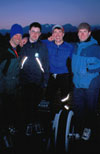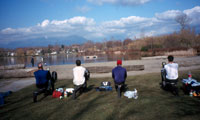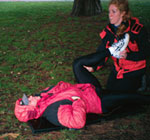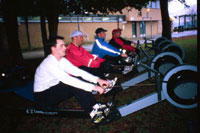|

| |
|

|
|
|
|
|
|





(click pictures for
larger images)
Although the rowers are not competitive with each other, they like to see how they compare. These are the nasty numbers as they stand at the end of March. April is the peak training month with the big 200k day and the back to backers.
If you want to attempt these distances on the Concept 2 indoor rowing machine, you can set the computer to measure up to 99.999k, and it will count down the seconds it takes for you to complete the distance. Keep in mind that breaks are included in the overall time, but if you leave the timer unattended for longer than about 4 minutes, it will shut itself off and you will lose your data. We recommend giving the bar a tug every couple of minutes when you're taking a break.
The Rowing Across Canada team has opted to go for sessions of 2 hours followed by a 15 minute group break. This simulates the schedule expected on the actual trip.
If your form is good, this is an exceptional way to burn calories and give your body a complete workout. We are all now lifelong Concept2 rowing machine fans. Give it a try! If you get some nice numbers in the longer distance pieces, let us know how you enjoyed it!
| Distance |
Dean |
Jono |
Kevin |
Mike |
Neil |
| . |
Minutes/seconds |
|
|
|
| 100m |
0:17 |
0:17 |
00:16.5 |
0:17 |
|
| 400m |
1:17 |
1:15 |
1:14 |
1:07 |
|
| 800m |
|
2:36 |
2:42 |
2:30 |
|
| 1600m |
5:48 |
5:58 |
5:40 |
5:26 |
|
| 2000m |
7:12 |
7:30 |
7:17 |
6:37 |
6:57 |
| 5k |
18:40 |
19:50 |
|
18:18 |
|
| 10k |
38:55:00 |
40:22:00 |
39:44:00 |
39:31:00 |
|
| 21.1k |
84:53:00 |
92:00:00 |
88:15:00 |
88:33:00 |
|
| . |
Hours/minutes/seconds |
. |
. |
. |
| 42.2k |
3:08:00 |
3:26:00 |
3:25:00 |
3:15:00 |
3:40:00 |
| 50k |
3:37:00 |
4:06:00 |
4:03:00 |
3:48:00 |
4:28:00 |
| 75k |
5:34:00 |
|
6:58:49 |
6:22:00 |
|
| 100k |
8:04:00 |
8:58:00 |
8:48:00 |
8:14:00 |
8:57:00 |
| 150k |
12:56:00 |
15:50:00 |
14:35:00 |
14:14:00 |
14:36:00 |
| 200k |
|
|
|
|
|
| . |
|
|
|
|
|
| *all
times include rest breaks |
|
|
|
The 100k-day
- Sunday, February 25, 2001
 This past Sunday Jono, Mike, Neil and Kevin attempted to come close to Deanís Saturday 100k effort. Prior to beginning, we had all agreed to take 15-minute breaks every 2 hours to simulate the stopping of the RoadBoat.
This past Sunday Jono, Mike, Neil and Kevin attempted to come close to Deanís Saturday 100k effort. Prior to beginning, we had all agreed to take 15-minute breaks every 2 hours to simulate the stopping of the RoadBoat.
Dean had set an incredible time of 8:04 including the 45 minutes of breaks, and Mike decided to attack that record. To do so, he had to hold 2:08 splits (that means it takes 2 minutes and 8 seconds to do 500 metres) for the first 4 hours. Yikes.
Meanwhile, Neil was pretty close to Mike by pumping out 2:13 splits for the first two hours while Jono and Kevin moseyed about in the 2:22 and 2:28 pastures respectively.
The first 15-minute break was nice, but nothing too special since all rowers are quite comfortable with a 2-hour session by now. Back on the C2ís, Mike got faster by holding 2:07ís for the whole time! Neil came back to reality by joining Jono and Kevin in the 2:25 to 2:27 region, but after this session, the 15-minute break was very welcomed.
For the third period, Mike was able to experience the joy of "The Bonk" which brought him down to a more comprehensible 2:25 pace, and the rest of the group saluted him for his previous efforts. This was to be a difficult period for all rowers, but everyone cheered each other on to make it to the 15-minute break, but 15 minutes goes pretty quick when youíre resting.
Thank goodness we had some visitors to help us through the challenging moments of the fourth session. We calculated our distances remaining, set the C2ís and began. It was not entirely pleasing to place our tired bums on the seats, but there we were.
Everyone struggled to the finish line in complete awe of Deanís 8:04. Mike still managed an impressive 8:33, Neil had earlier thought 50k would be enough, but he did the 100k in 8:56, with Kevin meandering in later with a 9:37 and Jono learning some nutritional lessons with his 9:51.
It was a fantastic experience with many levels of education. Each rower learned much about his individual needs. The next day uncovered much more information as some of us realized stretching would be a good thing to do more of, others noting that you can bruise your fingernails from the fleshy side if you row long enough, and many more exciting pieces of trivia.
Special thanks to Jane, Cheryl, Lisa, Eric and Maureen for coming out to cheer us on. Additional thanks to Melanie who tried to find us at the wrong lake. Thanks!
Next biggie is 150k at Kits Beach on Saturday, March 24th. Way to go team!
Coyote Kevin
|
|
|
Coaches Report
By: Craig Pond
Being a rowing coach one might perceive that I spend my time on the water teaching people how to row, in a boat, and did I mention on the water. Well this is true but recently I have accepted the challenge of teaching people how to row in a different environment, the road. Yes the challenge: take six men whom have never rowed, either on the water or on the land, and prepare them both technically and physically to row across the country in their road boat. No problem!
We are currently in the initial stages of training which entails rowing on the indoor rowing machine, the Concept2 rower, as many kilometers per week as physically possible. During weekly session with the team we have worked on technical parts of the rowing stroke which will help them develop their skills as rowers. The objective of these sessions is to rid the team of any technical habits they have formed in the previous weeks and provide them with technical goals for the weeks to come. Ultimately they will be efficient enough to row long distances on the machine using as little energy as possible to do so.
How do we physically prepare these men for up to 20 hours per day of continuous rowing in a road boat? Well we really don't know because it has never been done so we are innovating. As with any other endurance type sport the volume of training is more important than the intensity. Long steady state rows on the Concept II at low heart rates will prepare the team for the cardiovascular output they will require. In order to avoid injuries we have also adapted a weight training circuit that focuses on developing strength and endurance of the muscles involved in rowing.
So far so good, the team has been training hard and has shown excellent signs of improvement over the past few weeks. Stay tuned for reports on their future development.
|
|
|